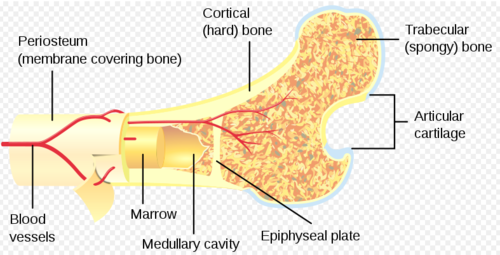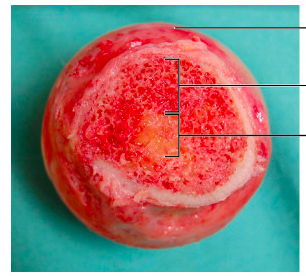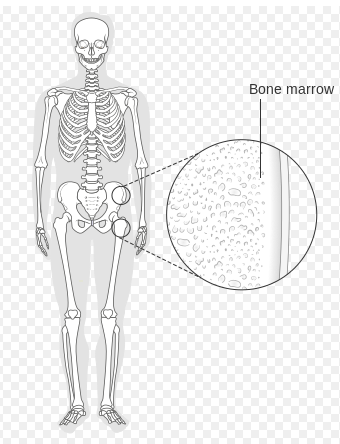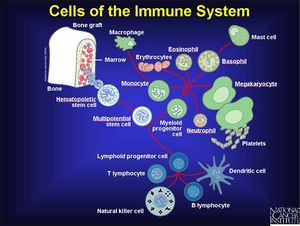Bone Marrow
Original Editor - Lucinda hampton
Top Contributors - Lucinda hampton and Kim Jackson
Introduction[edit | edit source]
The bony skeleton that supports the human body and facilitates locomotion has an intricate microarchitecture of its own. The cavities created by the trabecular arrangement of the core of the bones are occupied by a mixture of blood cells (across a large spectrum of development) and adipocytes. This tissue is known as Bone Marrow and is responsible for the production of blood cells (hematopoiesis).[1]
Bone marrow
- A component of the lymphatic system.
- Is the soft and flexible tissue in the cavities of bone[2].
- Bone marrow makes up about 4% of an adult human's weight (about 2.6 kilograms).
- Richly innervated and highly vascularized tissue.
- The major functions include: hematopoiesis; transporting oxygen; defense against foreign invasion; and hemostasis.[3]
- Helps to remove old cells from the circulation.
- Has both a vascular component and a non-vascular component.
- Two major types of bone marrow tissue: red marrow and yellow marrow.
Disease can impact the body's bone marrow.
- Low blood cell production is often a result of damage or disease.
- To correct, a bone marrow transplant may be performed so that the body can produce enough healthy blood cells.[2]
Structure and Gross Anatomy[edit | edit source]
Bone marrow is separated into a vascular section and non-vascular sections.
- Vascular section: contains blood vessels that supply the bone with nutrients and transport blood stem cells and mature blood cells away from the bone and into circulation.
- Non-vascular section: where hematopoiesis (blood cell formation) occurs. This area contains immature blood cells, fat cells, white blood cells (macrophages and plasma cells), and thin, branching fibers of reticular connective tissue.
While all blood cells are derived from bone marrow, some white blood cells mature in other organs such as the spleen, lymph nodes, and thymus gland.
- An uncommitted pluripotent stem cell undergoes proliferation and differentiation in an orderly fashion, producing immature committed progenitors. The progenitors ultimately produce mature committed cells that are released into the circulating blood.
- Cell production is controlled by a variety of regulatory mechanisms, including growth factors.
- The availability of recombinant growth factors has stimulated clinical trials of these factors in a wide variety of hematologic diseases[3].
Normal bone marrow is divided into red and yellow marrow, a distinction made on the grounds of how much fat it contains. Image at R: A piece of femur. The white ring is bone. The red spongy part is red bone marrow. The inner yellow circle is yellow marrow.[4]
- Red marrow is composed of
- Haematopoietic stem cells that produce two other types of stem cells: myeloid stem cells and lymphoid stem cells. These cells develop into red blood cells, white blood cells, or platelets.
- Supporting stroma
- Reticulum (phagocytes and undifferentiated progenitor cells)
- Scattered fat cells
- Rich vascular supply
- Confined mostly to skeletal system bones of the skull, pelvis, spine, ribs, sternum, shoulder blades, and near the point of attachment of the long bones of the arms and legs.
- Not only does red marrow produce blood cells, but it also helps to remove old cells from circulation, other organs, such as the spleen and liver, also filter aged and damaged blood cells from the blood.[2]
2. Yellow marrow:
- Has all the same constituents as red, except that fat cells make up the vast majority (80%, versus 40% in red marrow)
- Poor vascular supply
- Composed of hematopoietic tissue that has become inactive.
- Found in spongy bones and in the shaft of long bones[2].
- When blood supply is extremely low, yellow marrow can be converted to red marrow in order to produce more blood cells.[5]
Conversion of Bone Marrow[edit | edit source]
During infancy red marrow occupies the entire ossified skeleton except for epiphyses and apophyses.
Gradually red marrow 'retreats' centrally and by 25 years of age it is essentially confined to the axial skeleton (pelvis, spine, shoulder girdle, skull).
- The conversion of red to yellow marrow begins peripherally (phalanges) before occurring in the femora/humeri.
- Within the long bones, the epiphysis is the first to undergo conversion followed by the diaphysis before extending to the metadiaphysis.[5]
Bone Marrow Disease[edit | edit source]
Bone marrow that becomes damaged or diseased results in low blood cell production. These diseases compromise the immune system and deprive organs and tissues of the life-giving oxygen and nutrients they need.
In bone marrow disease, the body's bone marrow is not able to produce enough healthy blood cells.
- May develop from marrow and blood cancers, such as leukemia.
- Risk factors include: radiation exposure, certain kind of infections, and diseases including aplastic anemia and myelofibrosis.
A bone marrow transplant may be performed in order to treat blood and marrow diseases. Bone marrow produces hematopoietic stem cells. These stem cells normally develop into healthy red blood cells, white blood cells and platelets.
- A bone marrow or stem cell transplant replaces stem cells that are cancerous, faulty or destroyed by chemotherapy or radiation.
- The healthy stem cells can be obtained from the donor's blood or bone marrow.
- Bone marrow is extracted from bones located in places such as the hip or sternum.
- Stem cells may also be obtained from umbilical cord blood to be used for transplantation.[2]
References[edit | edit source]
- ↑ Ken hub Bone marrow Available from:https://www.kenhub.com/en/library/anatomy/histology-of-bone-marrow (last accessed 3.8.2020)
- ↑ 2.0 2.1 2.2 2.3 2.4 Thought co. Bone Marrow Available from:https://www.thoughtco.com/bone-marrow-anatomy-373236 (last accessed 3.8.2020)
- ↑ 3.0 3.1 Hays K. Physiology of normal bone marrow. InSeminars in oncology nursing 1990 Feb 1 (Vol. 6, No. 1, pp. 3-8). WB Saunders.Available from:https://pubmed.ncbi.nlm.nih.gov/2406826/ (last accessed 3.8.2020)
- ↑ Kiddle Bone marrow Available from:https://kids.kiddle.co/Bone_marrow (last accessed 3.8.2020)
- ↑ 5.0 5.1 Radiopedia Bone Marrow Available from:https://radiopaedia.org/articles/bone-marrow (last accessed 3.8.2020)










